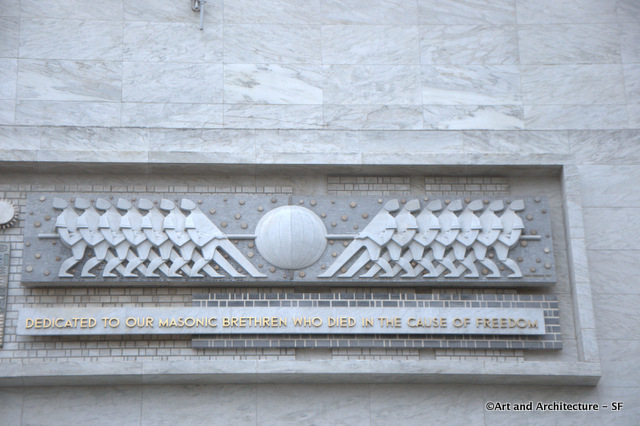1111 California Street
Nob Hill
Designed by Albert Roller (April 20, 1891 – July 12, 1981) the California Masonic Memorial Temple was dedicated on Sept. 29, 1958. An icon of mid-century modernist architecture, the structure is located at the top of Nob Hill across the street from Grace Cathedral. It is a testament to simple lines, open spaces, and heavy materials. Inside is an auditorium that seats 3,165, and 16,500 square feet of exhibit space.
 As its name suggests, the Temple also serves as a war memorial. The building’s façade features a sculpture, by Emile Norman, of four 12-foot-high figures, representing the branches of the armed forces. They are accompanied by a frieze of 14 marble figures engaged in a tug of war, representing the struggle between good and evil. The sculpture is inscribed: “Dedicated to Our Masonic Brethren Who Died in the Cause of Freedom.”
As its name suggests, the Temple also serves as a war memorial. The building’s façade features a sculpture, by Emile Norman, of four 12-foot-high figures, representing the branches of the armed forces. They are accompanied by a frieze of 14 marble figures engaged in a tug of war, representing the struggle between good and evil. The sculpture is inscribed: “Dedicated to Our Masonic Brethren Who Died in the Cause of Freedom.”
*
From Norman’s 2009 obituary in the Los Angeles Times:
Born in 1918 in San Gabriel to walnut ranchers and truck farmers, Norman carved his first piece of art from a riverside rock when he was 11.
He ruined his father’s chisels, but the results gained his father’s respect.
Norman enrolled in art school but dropped out after one day when a teacher told him he was doing the assignment “the wrong way,” according to his website.
Art resulted from inspiration, not books, he later said.
He found his in the natural surroundings of his youth; in Big Sur, where he had lived since 1946; and with his life partner, Brooks Clement, who arrived to fix Norman’s radio in 1943 and stayed to manage his career.
Married actors Michael Tucker and Jill Eikenberry produced a documentary, “Emile Norman: By His Own Design,” about their former Big Sur neighbor partly because they wanted to share the inspirational effect Norman had on them and the lives of many others.
The idea behind the title of the film is that “he designed his life as well as his art,” Eikenberry told The Times on Friday. “He created this extraordinary life in Big Sur with Brooks when it was not safe to be gay. . . . They had this incredible freedom to create the life they wanted at a time when people were hiding in closets.”
Clement told Norman, “You go into the studio and I’ll show the world what you’re doing,” according to the documentary, which debuted on PBS last year.
Norman’s biggest commission was the four-story window that he completed in the late 1950s, with Clement’s assistance, for the entrance to the Masonic Memorial Temple on San Francisco’s Nob Hill. The window depicts the Masons’ heritage and role in the development of California.
To create it, Norman used a technique he developed and named “endo-mosaic.” The process involved suspending crushed glass and other materials — such as metal, fabric, shells and dirt — between clear sheets of translucent plastic.
He also carved the sculptural reliefs in the marble on the outside of the Masonic building and earned about $100,000 for the entire project, Mallory said.
“They were successful very early. That just drove him incessantly to come up with new stuff,” Mallory said. “The confidence was there.”
Early in his career, Norman produced window displays for Bullocks Wilshire and made props for films, including plastic headdresses for the chorus girls in the 1946 Fred Astaire film “Blue Skies.”
When Norman’s club foot kept him out of the military during World War II, he moved to New York in 1943. He began experimenting with his endo-mosaic technique while designing window displays for Bergdorf Goodman in New York.
The plastic and wood-inlay sculptures he placed in windows brought him critical notice, and by 1951 he had his first major show as a non-commercial artist, at the Feingarten Gallery in New York.
The modernism then in vogue in New York’s art world “turned him off,” Mallory said, and Norman returned to Big Sur for good in 1961 to create nature-inspired carvings and reliefs.
His use of natural wood colors and homemade epoxy were particularly recognized, and his fork-shaped renditions of birds in flight became a signature, according to a 2008 article in the Monterey County Herald.
On a ridge overlooking the Pacific Ocean, Norman and Clement hand-built their home and filled it with Norman’s art. Friends called them “Clemile.”
Clement opened and ran Norman’s gallery in Carmel and documented his partner’s art and techniques before dying of cancer in 1973.
While shopping for a vacation home in the 1980s, Tucker and Eikenberry met Norman, who had land for sale. When they waffled over buying it, Norman gestured and said, “Life is short,” Tucker recalled.
The couple bought the land and, during the dozen or so years they lived there, delighted in bringing friends to meet Norman.
“Their lives would be changed, as ours were,” Tucker said. “The way he looked at his art and work was a calling. It flowed through him. He was the purest artist I ever met.”
The end of Norman’s life was “very much like he predicted,” Tucker said. “He was famous for saying, ‘The minute I can’t work, call 911,’ and he worked until the last week of his life.”
The last piece Norman finished was of an owl.
*The window that is mentioned in the obituary is inside the Masonic Temple.



Love the sculpture and the story!